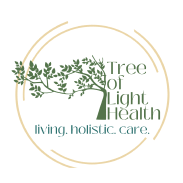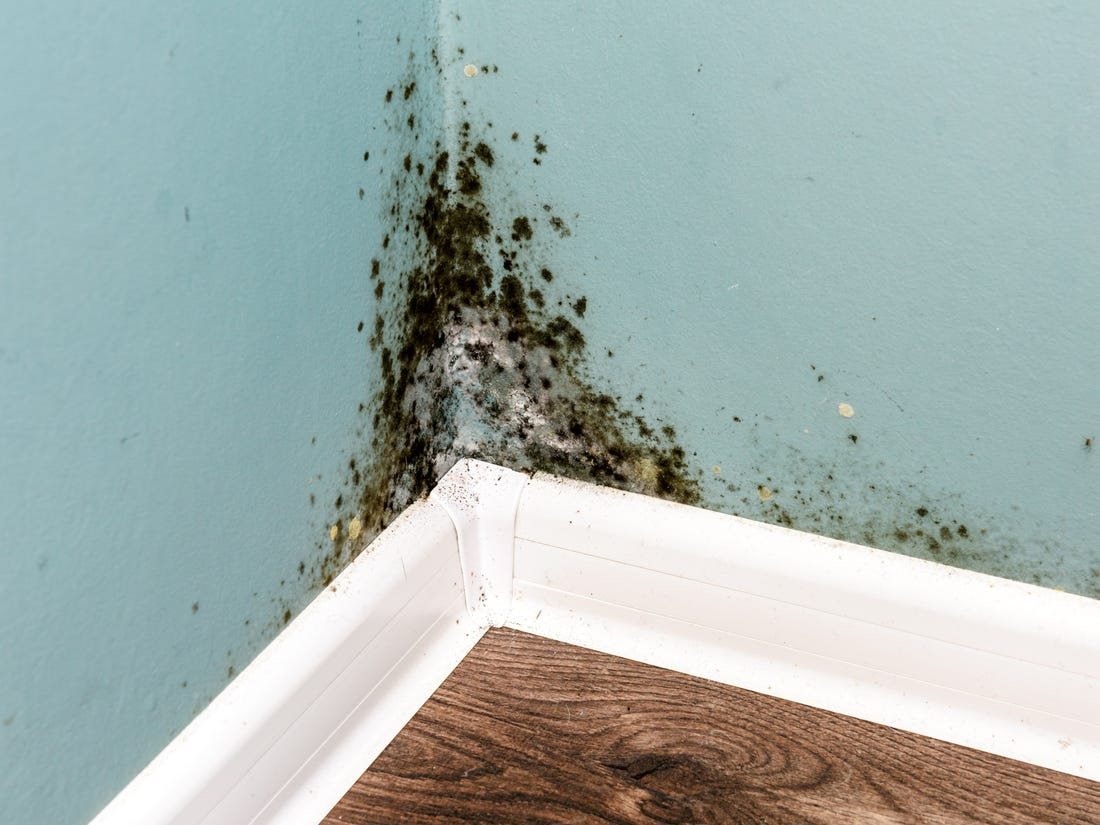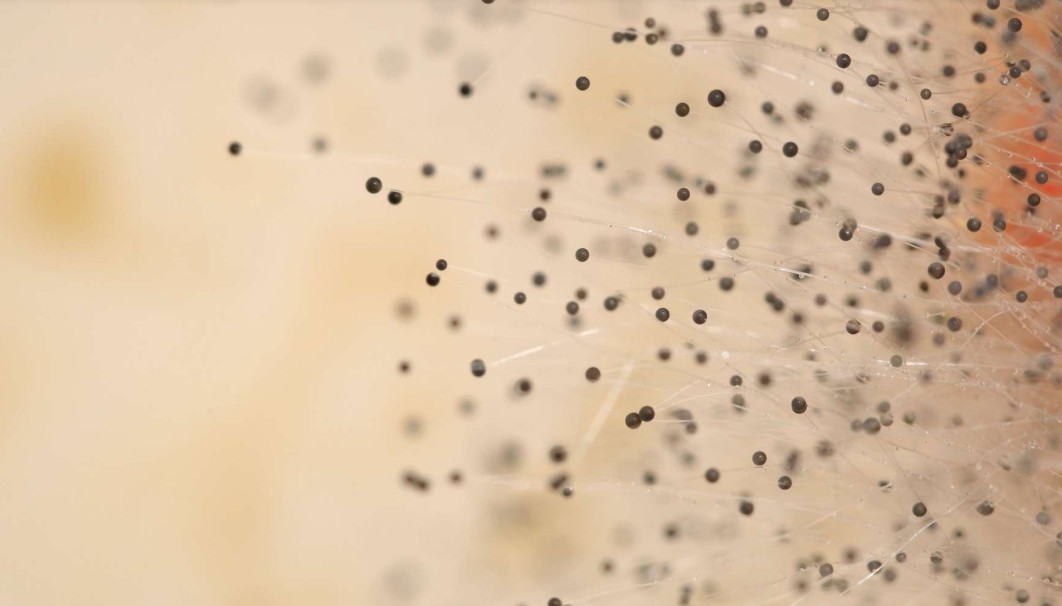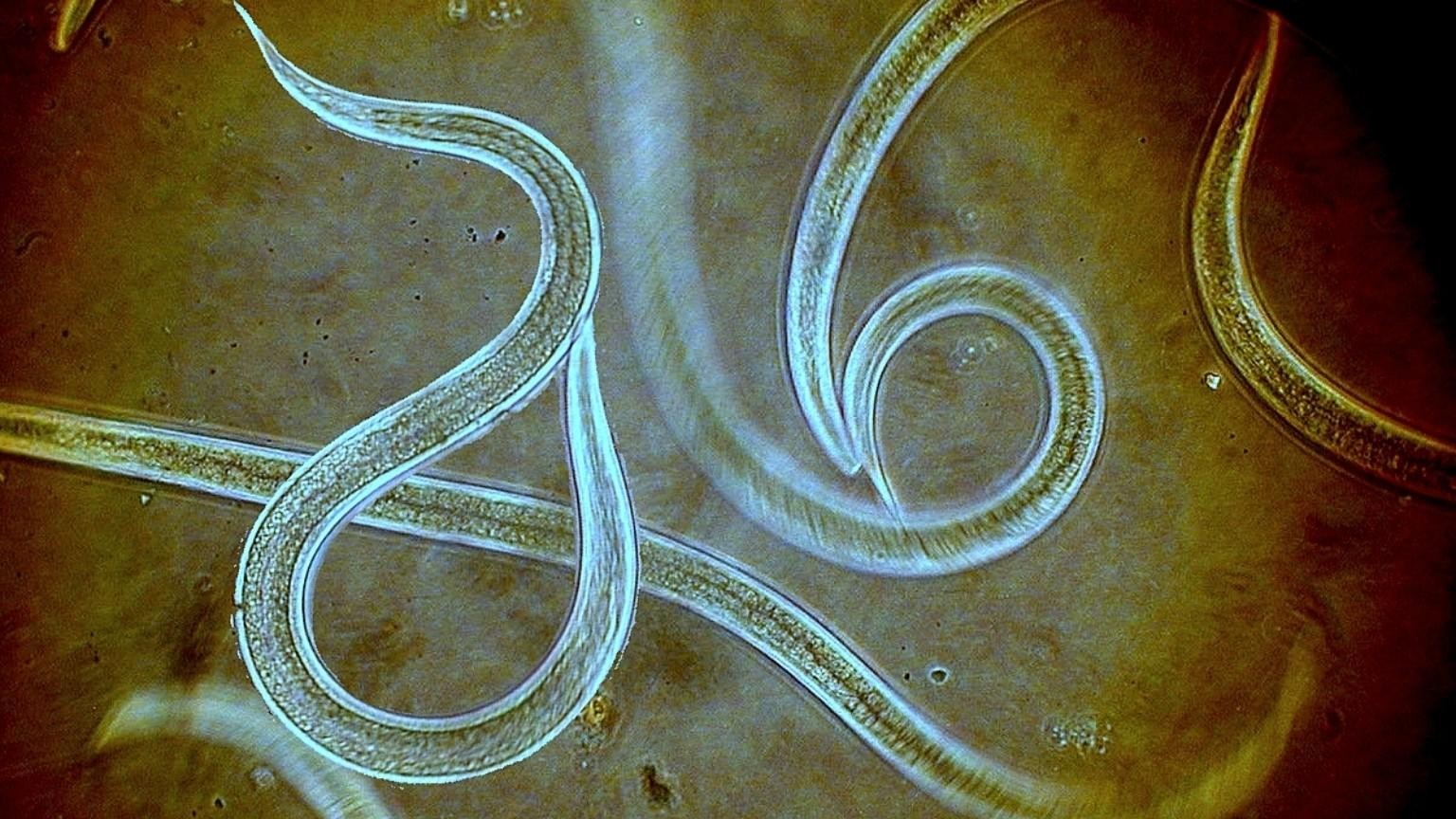Over the past 20 years, exposure to mycotoxin-producing mold has been recognized as a significant health risk because of biotoxin illness. Scientific literature has demonstrated mycotoxins as a possible cause of human disease in water-damaged buildings (WDB).
In a study of 112 patients who were diagnosed with chronic fatigue syndrome, 93% of those patients had at least one mycotoxin detected in the urine.
Mycotoxins are produced from mold spores and are typically the result of exposure to water-damaged buildings (WDB) (homes, schools, and places of business). Molds are ALWAYS present in homes or workplaces that are water-damaged, and they are ALWAYS producing mycotoxins. Water-damaged environments contain a complex mixture of contaminants produced by both molds, including Gram-negative and Gram-positive bacteria. These secondary metabolites of molds and bacteria have been identified in the dust, carpeting, wallpaper, heating, ventilation, air-conditioning (HVAC) systems, and respirable airborne particulates. Molds can also produce something called volatile organic compounds that give the familiar “musty odor” smell… These compounds are also very hazardous to health. However, keep in mind that toxic mycotoxins produced from mold have no odor.
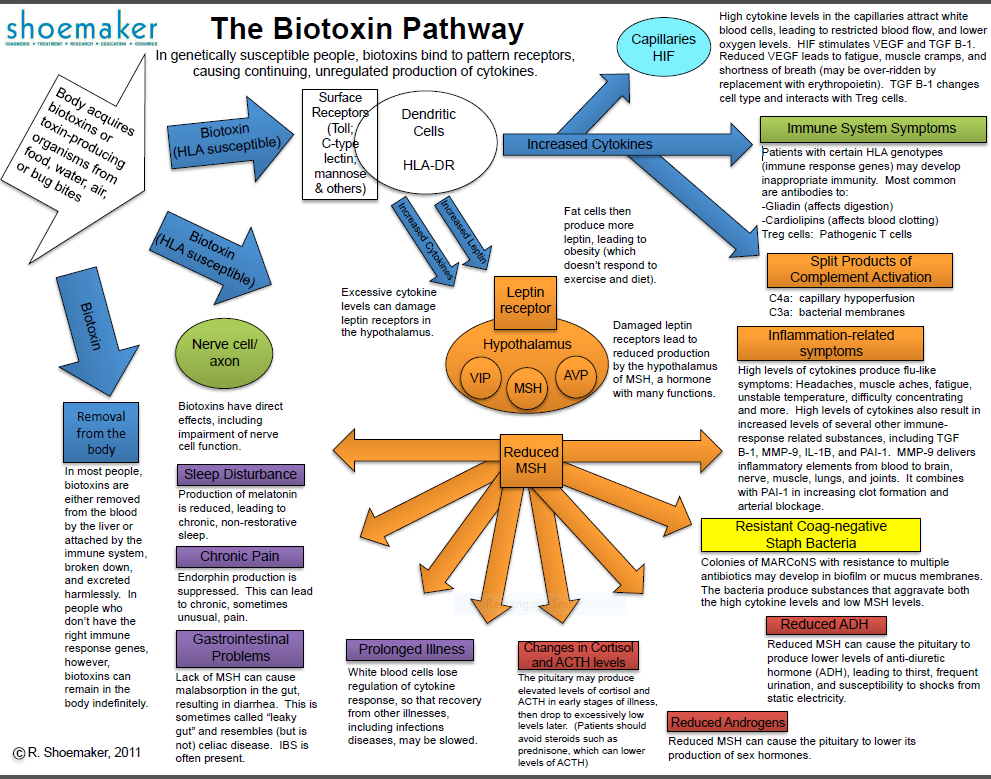 Source: Dr. Shoemaker MD https://www.survivingmold.com/diagnosis/the-biotoxin-pathway
Source: Dr. Shoemaker MD https://www.survivingmold.com/diagnosis/the-biotoxin-pathway
Not everyone who is exposed to mold mycotoxins will have an allergic reaction or become symptomatic. This is due to individual differences in genetics and biochemistry. For example, it is known that about 20 to 25% of the population is not able to detox mycotoxins very well. These susceptible individuals may experience symptoms of mold exposure, while loved ones or family members may not. This is due to the differences in how someone processes the mycotoxins through the biotoxin pathway, as proposed by Dr. Ricky Shoemaker MD.
Unfortunately, mycotoxins are linked to many chronic diseases, including:
- Autism
- Alzheimer’s and Parkinson’s Disease
- Chronic fatigue and fibromyalgia
- Asthma
- Fungal Sinusitis
- Multiple sclerosis
- Obesity
- Immune suppression
- Cancer
Keep in mind that there are overlaps between mycotoxin illness and some of the chronic illnesses such as Lyme and Autism. In some cases, diseases like Lyme, Autism, fibromyalgia, and chronic fatigue may be misdiagnosed and, in reality, are due to mycotoxins. In this way, mold can be thought of as the great masquerader of other illnesses.
“It is important to note that one’s health cannot be improved if one is continually exposed to mold and mycotoxins.”
Therefore, a thorough evaluation of one’s home is prudent if one suspects exposure to water-damaged buildings.
It is also important to note that one can become ‘colonized’ in the gut and sinuses long after exposure to a water-damaged building, especially with mycotoxins. Therefore, one may not be living in a toxic environment but still be positive for mycotoxins with all the signs and symptoms of mycotoxin toxicity.
Some of the signs and symptoms of chronic mold exposure include:
♦Fatigue ♦Weakness ♦Aches ♦Muscle Cramps ♦Unusual Pain ♦Ice Pick Pain ♦Headache ♦Light Sensitivity ♦Red Eyes ♦Blurred Vision ♦Tearing ♦Sinus Problems ♦Cough ♦Shortness of Breath ♦Abdominal Pain ♦Diarrhea ♦Joint Pain ♦Morning Stiffness ♦Memory Issues ♦Focus/Concentration Issues ♦Word Recollection Issues ♦Decreased Learning of New Knowledge ♦Confusion ♦Disorientation ♦Skin Sensitivity ♦Mood Swings ♦Appetite Swings ♦Sweats (especially night sweats) ♦Temperature Regulation or Dysregulation Problems ♦Excessive Thirst ♦Increased Urination ♦Static Shocks ♦Numbness ♦Tingling ♦Vertigo ♦Metallic Taste ♦Tremors
Testing:
If one suspects exposure to mold or mycotoxin, we suggest performing a visual contrast test at https://www.survivingmold.com/store1/online-screening-test. Keep in mind that this testing is not diagnostic and is only a screening tool.
In addition, there are several labs performing mycotoxin testing. We prefer serum testing or immunoglobulins, as we find this to be more accurate.
Also, there are extensive laboratory tests to look for inflammatory markers and other markers of inflammation caused by mold. Please get in touch with our office for more info.
Assessing mold and water damage in buildings can be challenging and, regrettably, often comes with a significant cost. If you have any suspicions of mold or water damage, it is advisable to seek the expertise of a professional for a thorough evaluation. We have a network of qualified professionals we can connect you with. Additionally, there are home testing options available, such as ERMIE (https://www.emlab.com/services/ermi-testing/). For further details, please get in touch with our office.
Marcons:
One particular feature of mold toxicity is a specific type of bacteria called MARCONS, which can have multiple downstream effects, including sleep disruption, mood swings, fatigue, etc. MARCONS, or Multiple Antibiotic Resistant Coagulase Negative Staphylococci), is an antibiotic-resistant staph that resides deep in the nasal passage of 80% of people with low MSH (Melanocyte-Stimulating Hormone), those suffering from Biotoxin Illness and other chronic inflammatory illnesses like CIRS (Chronic Inflammatory Response Syndrome. A good blog article that summarizes this is found at http://biotoxinjourney.com/marcons/. Also, see https://www.survivingmold.com/faq/marcons .
We have developed specialized testing and treatment for this problem. Please get in touch with our office for further evaluation and testing.
Types of Mycotoxins
While it is known that there could be hundreds of different types of mycotoxins, these are the mycotoxins that typically cause symptoms:
-
Satratoxin
-
Verrucarin and Verrucarol
-
Ochratoxin (A and B)
-
T2 Toxin
-
Vomitoxin aka Deoxynivalenol
-
Cladosporium toxin (Cladosporium HSP 70)
-
Alternaria toxin (Alternariol)
-
Aspergillus Toxin (Aspergillus hemolysin)
-
Aspergillus Auto-Toxin (Sterigmatocystin)
-
Penicillium Toxin (Mycophenolic acid)
-
Asp/Pen Neuro Auto-Toxin (Gliotoxin)
-
Stachybotrys Toxin (Trichothecene)
Treatment:
Again, we would like to emphasize that if mold is detected in the environment, one must engage in comprehensive mold remediation to get better.
The Dr. Ricky Shoemaker mold protocol is a comprehensive approach that we’ve found effective in addressing mold and mycotoxin-related illnesses. For additional details, please visit www.survivingmold.com.
We use a combination of mycotoxin binders, antifungals, immune support, detoxification support, emotional support, and various organ supports. We find that frequency-specific microcurrent to be a helpful adjunctive treatment. There are also various ways to reduce multiple accounts in the home.
Overall, mold and mycotoxin stress is a very complex problem that takes enormous patience, skill, and perseverance to navigate. If you suspect you could have a mold or mycotoxin problem, please get in touch with our office for further evaluation.
References
1. Detection of Mycotoxins in Patients with Chronic Fatigue Syndrome https://www.mdpi.com/2072-6651/5/4/605/htm
2. Chronic Illness Associated with Mold and Mycotoxins: Is Naso-Sinus Fungal Biofilm the Culprit? https://www.ncbi.nlm.nih.gov/pmc/articles/PMC3920250/
3. Mechanisms of Mycotoxin-Induced Neurotoxicity through Oxidative Stress-Associated Pathways
4. https://www.ncbi.nlm.nih.gov/pmc/articles/PMC3179161/
5. Symptoms of mold toxicity: https://www.survivingmold.com/mold-symptoms
6. Campbell MD, https://mymycolab.com/
7. Akbari, P, Braber S. et al. , “Deoxynivalenol: A Trigger for Intestinal Integrity Breakdown.” The FASEB Journal 28.6
(2014): 2414-429.Andersson M, Nikulin M, et al. Bacteria, molds and toxins in
water-damaged building materials. Appl Environ Microbiol
1997 63:387-93.
8. Anyanwu E, Campbell A, et al. Brainstem Auditory Evoked
Response in Adolescents with Acoustic Mycotic Neuroma Due
to Environmental Exposure to Toxic Molds. Int J Adolesc Med
Health, March 2002.
9. Anyanwu E, Campbell A, et al. Neurophysiological Effects of
Chronic Indoor Environmental Toxic Mold Exposure on
Children. ScientificWorldJournal, 3:281-290, April 28, 2003.
10. Anyanwu E, Campbell A, et al. The Neurological Significance of
Abnormal Natural Killer Cell Activity in Chronic Toxigenic
Mold Exposures. ScientificWorldJournal, 3:1128-1137, 2003.
11. Anyanwu E. The validity of the environmental neurotoxic
effects of toxigenic molds and mycotoxins. . The Internet J of
Toxicology. 2008;5(2) DOI:10.5580/2099b.
12. Anyanwu E, Ehiri J, et al. Application, effectiveness, and
limitations of the electrophysiological diagnosis of neurotoxic
effects of chronic environmental mycotoxins in humans. Int J
Adolesc Med Health. 2004 Apr-Jun;16(2):107-18.
13. Anyanwu E, Morad M, Campbell AW. Metabolism of
mycotoxins, intracellular functions of vitamin B12, and
neurological manifestations in patients with chronic toxigenic
mold exposures. A review. Scientific World Journal. 2004 Aug
26;4:736-45.
14. Bin-Umer M, McLaughlin J, et al. Trichothecene mycotoxins
inhibit mitochondrial translation–implication for the
mechanism of toxicity. Toxins (Basel). 2011 Dec; 3(12):1484-
501.
15. Bloom E, Grimsley L, et al. Molds and mycotoxins in dust
from water-damaged homes in New Orleans after hurricane
Katrina. Indoor Air. 2009 Jan 28.
16. Bloom E, Nyman E, et al. Molds and mycotoxins in
indoor environments – A survey in water-damaged buildings. J
Occupational Environ Hygiene 2009 6:671-78.
17. Bondy G, Pestka J. Immunomodulation by Fungal
Toxins. Journal of Toxicology and Environmental Health, Part
B, 3:109-143, 2000.
18. Boonen J, Malysheva S, et al. Human skin penetration of
selected model mycotoxins. Toxicology, vol. 301, no. 1-3, pp.
21-32, 2012
